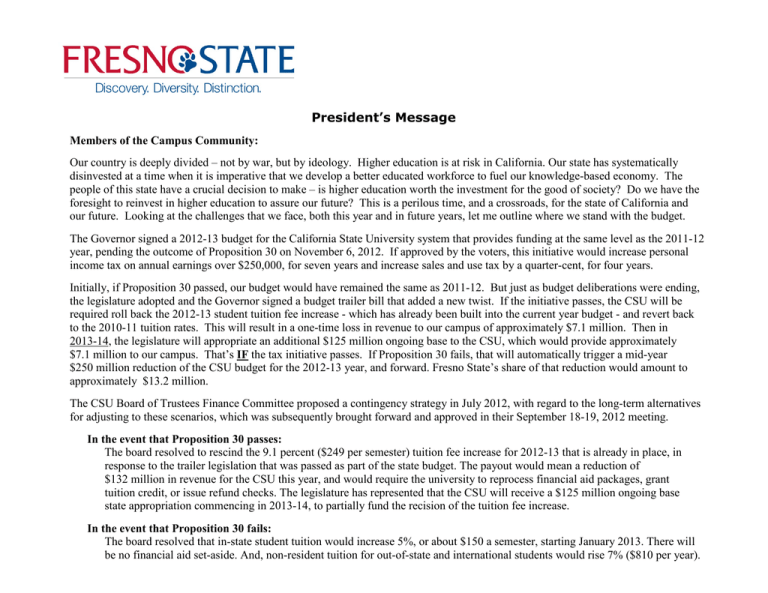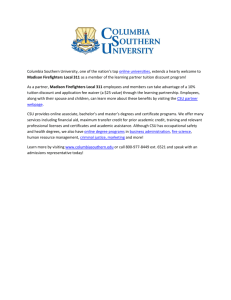President’s Message
advertisement

President’s Message Members of the Campus Community: Our country is deeply divided – not by war, but by ideology. Higher education is at risk in California. Our state has systematically disinvested at a time when it is imperative that we develop a better educated workforce to fuel our knowledge-based economy. The people of this state have a crucial decision to make – is higher education worth the investment for the good of society? Do we have the foresight to reinvest in higher education to assure our future? This is a perilous time, and a crossroads, for the state of California and our future. Looking at the challenges that we face, both this year and in future years, let me outline where we stand with the budget. The Governor signed a 2012-13 budget for the California State University system that provides funding at the same level as the 2011-12 year, pending the outcome of Proposition 30 on November 6, 2012. If approved by the voters, this initiative would increase personal income tax on annual earnings over $250,000, for seven years and increase sales and use tax by a quarter-cent, for four years. Initially, if Proposition 30 passed, our budget would have remained the same as 2011-12. But just as budget deliberations were ending, the legislature adopted and the Governor signed a budget trailer bill that added a new twist. If the initiative passes, the CSU will be required roll back the 2012-13 student tuition fee increase - which has already been built into the current year budget - and revert back to the 2010-11 tuition rates. This will result in a one-time loss in revenue to our campus of approximately $7.1 million. Then in 2013-14, the legislature will appropriate an additional $125 million ongoing base to the CSU, which would provide approximately $7.1 million to our campus. That’s IF the tax initiative passes. If Proposition 30 fails, that will automatically trigger a mid-year $250 million reduction of the CSU budget for the 2012-13 year, and forward. Fresno State’s share of that reduction would amount to approximately $13.2 million. The CSU Board of Trustees Finance Committee proposed a contingency strategy in July 2012, with regard to the long-term alternatives for adjusting to these scenarios, which was subsequently brought forward and approved in their September 18-19, 2012 meeting. In the event that Proposition 30 passes: The board resolved to rescind the 9.1 percent ($249 per semester) tuition fee increase for 2012-13 that is already in place, in response to the trailer legislation that was passed as part of the state budget. The payout would mean a reduction of $132 million in revenue for the CSU this year, and would require the university to reprocess financial aid packages, grant tuition credit, or issue refund checks. The legislature has represented that the CSU will receive a $125 million ongoing base state appropriation commencing in 2013-14, to partially fund the recision of the tuition fee increase. In the event that Proposition 30 fails: The board resolved that in-state student tuition would increase 5%, or about $150 a semester, starting January 2013. There will be no financial aid set-aside. And, non-resident tuition for out-of-state and international students would rise 7% ($810 per year). Regardless of the outcome, pass or fail: The board endorsed the contingency plan presented and directed the chancellor to take such actions as necessary to implement the plan with consultation with faculty, staff and students, and provided the Chancellor the authority to amend the plan as necessary to respond to subsequent actions by the state. The key strategies are outlined below: • • • • Change to Health Care Benefits Cost-Sharing - A modification of the employer/employee health care contributions is recommended, effective in 2013-14, pending negotiations with our bargaining units. Increase in Systemwide Administrative Efficiencies - Systemwide administrative initiatives will be launched to increase efficiencies and effectiveness of administrative functions such as: a. the Common Financial System(CFS) and the Common Human Resources System(CHRS); b. a Systemwide Shared Services Center for purchasing and accounts payable; c. the Virtual Information Security Center and Network Operations Center; d. the spend analysis; e. shared police call centers, construction management, and Chief Information Officers. Campus Specific Strategies - specific strategies will be implemented including: a. The reduction of Faculty assigned/release time and sabbaticals. b. Additional reductions in workforce through attrition, non-renewals of contracts, and layoffs may be necessary. c. Campuses will be expected to use reserves or carryforward as one-time resources. One-Time Transfer of CERF - Campuses will be expected to draw on their continuing education reserves on a one time basis, using authority granted to the CSU under current legislation. The board voted to postpone a decision until November on several additional fee policy changes regarding the implementation of a graduation incentive fee, a course repeat fee, and a third tier tuition fee, all of which are intended to improve access to classes and reduce time to graduation. All new student enrollments for the spring semester 2013 has been frozen, the only exceptions being in health and education programs where we have partnership commitments to meet. This step is necessary for spring 2013 since we cannot afford to admit students who we will not be able to serve. To compound the uncertainty, there is the potential reduction of federal financial aid and grant dollars on January 2, 2013, should Congress fail to act to balance their budget timely. Since we could not wait until November to adopt a budget for the current year, we have taken steps to disrupt our University environment as minimally as possible. Because of our past prudent budgeting, we have sufficient reserves and carry-forward dollars to allow us to “bridge” this gap for 2012-13, to keep divisions, schools and colleges at the same budget level as 2011-12, should the budget initiative pass or fail. In 2011-12, we set aside $7.2 million from central reserves and $6 million in carry-forward dollars from various Divisions, to absorb the immediate reduction of our worst case scenario that the $250 million trigger is pulled. After the funds were reserved to cover this year's shortfall of $13.2 million, our central reserves consisted of approximately $11 million and divisional reserves amounted to approximately $30 million. Normally we maintain approximately $25 million in reserve and carryforward for on-going operations. This leaves a cushion of approximately $16 million as we begin to plan for the permanent base budget reduction of $13.2 million for the 2013-14 year. This cushion will allow us to make careful, deliberate changes over a one-to-two year period without the need for dramatic disruption of our university community. The caveat is that these are one-time funds that will be gone after we use them, as we make longer term base-budget reductions. I have reviewed this strategy with the University Resources Advisory Board, the University Budget Committee and the Academic Senate expanded committee this summer and they have concurred with this approach. I am deeply grateful for the responsible management of funds that everyone has engaged in since 2008. Our ongoing efforts to maintain a prudent fiscal reserve has allowed us to take the time to plan responsibly and equitably, to adopt whatever budget cuts that may be required of us. With those allocations made, we look forward to welcoming about 22,400 students to the campus this fall. That will represent an enrollment increase of approximately 700 over last year, with the largest freshman class we have had - over 3,100. As a result of our enrollment increase, we have allocated an additional $1 million in the fall semester to schools and colleges to increase the number of courses and reduce class size in selected courses. We will allocate an additional $1 million in the spring semester, dependent upon the results of the November election. If the November tax initiative fails, we will become a much smaller and leaner University. We will have to reconsider the number and breadth of programs we offer. This fall, we will begin work on planning for future alternatives. We will work closely with the University Budget Committee of the Academic Senate to examine those alternatives and options, and devise a process to review our Level A allocation levels. The Budget Committee is currently working on developing a revised Level B budget formula that accounts for all of the University funds that are available to Academic Affairs. These revisions must be in place for the 2013-14 fiscal year. Our entire University community has sacrificed and suffered. I am deeply grateful for your commitment and willingness to do what is necessary to enable us to continue providing access and a quality education for the students of Central California. Despite the dramatic changes and challenges that we have faced, our University has continued to record a number of great accomplishments, despite the fact that we have fewer employees and more students to serve. Be very proud of your University, and, of what we have accomplished. We must continue to plan for the future, which hopefully will be much brighter than it has been the past four years. We must remain focused on achieving the goals outlined in our Plan for Excellence IV, which are designed to help students to be successful. Here are a few of the major steps we will take this year.


